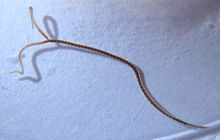| Lumbriculus variegatus | |
|---|---|

| |
| Two-tailed specimen of Lumbriculus variegatus; the second tail might have been grown due to the injury to the first | |
| Scientific classification | |
| Domain: | Eukaryota |
| Kingdom: | Animalia |
| Phylum: | Annelida |
| Clade: | Pleistoannelida |
| Clade: | Sedentaria |
| Class: | Clitellata |
| Order: | Lumbriculida |
| Family: | Lumbriculidae |
| Genus: | Lumbriculus |
| Species: | L. variegatus
|
| Binomial name | |
| Lumbriculus variegatus (Muller, 1774)
| |
| Synonyms | |
|
Lumbriculus kareliensis Popčhenko, 1976 | |
Lumbriculus variegatus, also known as the blackworm or California blackworm or Australian Blackworm, is a species of worm inhabiting North America Europe and Australia. It lives in shallow-water marshes, ponds, and swamps, feeding on microorganisms and organic material. The maximum length of a specimen is 10 cm (3.9 in). Worms raised in laboratory environment are slightly shorter, with 4 to 6 cm (1.6 to 2.4 in) long bodies. An adult individual has approximately 150 to 250 1.5 mm wide segments,[1] each of which has the ability to regenerate into a new individual when separated from the rest of the animal. In most populations, this is the primary mode of reproduction, and mature individuals are exceedingly rare; in large areas (including Asia, most of North America and the greater part of Europe) mature individuals have never been found. The name blackworm is given to at least three distinct species of worm that are identical in appearance and were once considered a single species.[2]
- ^ "Lumbriculus variegatus". www.eeob.iastate.edu. Archived from the original on 2022-07-04. Retrieved 2021-04-25.
- ^ Gustafsson, Daniel R.; Price, David A.; Erséus, Christer (2009). "Genetic variation in the popular lab worm Lumbriculus variegatus (Annelida: Clitellata: Lumbriculidae) reveals cryptic speciation". Molecular Phylogenetics and Evolution. 51 (2): 182–189. doi:10.1016/j.ympev.2008.12.016. PMID 19141324.